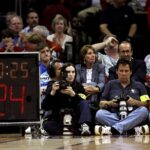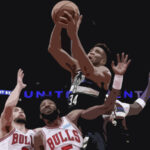While basketball is not considered a contact sport, there is still a lot of contact involved.
Blatant and violent contact can lead to severe punishment, such as an ejection and additional suspension.
Meanwhile, unintentional or soft contact is common in the game, but will result in a personal foul.
Players are permitted up to six personal fouls throughout the game. On the sixth, they are removed from play.
Typical personal fouls include reach-in, charging, holding and blocking fouls. This list is not exhaustive.
Some of them are offensive fouls while others are defensive.
For example, charging is when the ball carrier knocks into a stationary defender while attempting to score.
As such, charging is a common offensive foul.
A blocking foul also involves the ball carrier, but they are on the receiving end this time.
With that in mind, let’s answer the question you came here for…
What is a Blocking Foul in Basketball?
A blocking foul is a foul in which the defender makes illegal contact with the ball carrier by impeding their movement. The defender could initiate the contact while the ball carrier is dribbling on the court or driving to the net. Blocking fouls are categorized as personal fouls since the contact isn’t considered excessive.
If the referee deems that there is a blocking foul, he will whistle the play dead and gesture to signal the type of call.
As a note, a blocking foul can also be called on the defender against an opponent who isn't in possession of the ball.
While it is less common, you cannot deliberately restrict the movement of your opponents on the court without the risk of being called.
End Result of a Blocking Foul
A blocking foul leads to one of 2 outcomes: free throws or inbound possession.
Free Throws
If the fouled player was in the process of shooting, he’ll be sent to the free throw line.
Depending on the type of shot and the outcome of the play, the shooter can be rewarded with up to 3 free throws.
So, if the player scored a three pointer while drawing the blocking foul, he’ll be given an extra free throw to complete a four-point play.
As a note, you’ll often hear the commentators scream “and 1” when the shooter scores the bucket on a foul play.
Should the shooter miss the attempt, they will be given as many free throws as the shot they attempted was worth.
A missed field goal grants you 2 free throws, while a missed three-pointer results in 3 free throws.
Out of Bounds
If the blocking foul happens during the dribble, the play is whistled down and the offensive team will resume possession from the sidelines.
However, the circumstances do change if the defending team lands into foul trouble.
When a team no longer has any more fouls to give, the opponents are automatically rewarded with two free throws.
You’ll often see this happen in the late stages of the game.
Blocking Foul vs Charging Foul
The line between a blocking foul and a charging foul is ever so thin.
To clarify, a charging foul is a foul assessed to the ball carrier for knocking into the defender, whose position was already established on a play.
The rule is that the ball carrier can’t simply bulldoze through their opponent to drive the net or free space up on the court.
And as a reminder, the defender can’t deliberately step into a position to impede the ball carrier (blocking foul).
The referee is left to decide which player established their position first.
These plays happen so fast, and the referee is left to make the call on the spot.
Sometimes to dismay or pleasure of the fans, who “might” have a slight bias in the matter.
Blocking Foul Call
As with any foul, the referee makes a gesture to signal the call.
While you might not know it, the fans in audience typically know what each gesture means.
So, when they see the motion for the blocking foul call, they immediately erupt to celebrate or protest the referee’s decision.
In any case, the ref will start off by raising his hand with a closed fist to indicate a personal foul is being called.
He then proceeds to gesture the blocking foul by placing both his hands on the hips.

Restricted Area Arc
There is an area under the hoop which was added to prevent defenders from drawing an offensive charging foul.
You’ll notice an arc which extends out to 4.1 feet (or 1.25m), with the area inside considered as restricted.
Therefore, if a defender impedes the movement of the player while standing inside the arc, they will be assessed a blocking foul.
However, the restricted area is ignored when the defender jumps to block a shot or when they stand outside the perimeter.
In essence, the restricted area arc is the only place where a blocking foul is clear cut.
Final Thoughts
Players on both teams know very well that the difference between a blocking and charging foul is very slim.
Often, you’ll see the players on both sides do their best to sell the foul in their favor.
Expect to see some Hollywood-level flopping out there.
In fairness, NBA players are very big men facing one another and them challenging for position is quite admirable.
Especially when the defender puts his body on the line to an opponent posting up.
That is some serious commitment to both the team and protecting the hoop.
And getting charged with the blocking foul only adds insult to injury.
But rules are rules.






